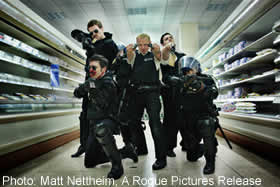 The recently released film by Simon Pegg and Edgar Wright, Hot Fuzz, serves as their second installment of an apparent series of comedic parodies following their wildly popular zombie-horror flick Shaun of the Dead. Being an avid fan of Shaun of the Dead myself, I found Hot Fuzz to be just as comically satisfying as their previous endeavor. It focuses on presenting the action-packed adrenaline rush that is ubiquitous in most action films. More precisely, the film shines during its unrealistically epic gun-fight sequences—it’s ending in particular.
The recently released film by Simon Pegg and Edgar Wright, Hot Fuzz, serves as their second installment of an apparent series of comedic parodies following their wildly popular zombie-horror flick Shaun of the Dead. Being an avid fan of Shaun of the Dead myself, I found Hot Fuzz to be just as comically satisfying as their previous endeavor. It focuses on presenting the action-packed adrenaline rush that is ubiquitous in most action films. More precisely, the film shines during its unrealistically epic gun-fight sequences—it’s ending in particular. Being a film focused on presenting intense visuals, creative elements such as symbolism are scarce. We can, however, assume that the Peace-Lily that main character Sergeant Angel tends to so devotedly is a representation
 of the tranquility he desperately needs in his life, as well as the tragic lack of another devotion—a family, for example. This is due to his undying love for his work as a police officer, which renders him unable to have a life of his own. In addition to this, school children serve as an important symbol of rebellion and freedom. Referred to as “hoodies” for the hooded sweatshirts they wear, these kids are deeply resented by the townspeople for loitering, and basically just for existing and cluttering up their village’s “perfect image”. However, as the story unfolds and it becomes clear to the viewer that the entire town is part of a gruesome and murderous
of the tranquility he desperately needs in his life, as well as the tragic lack of another devotion—a family, for example. This is due to his undying love for his work as a police officer, which renders him unable to have a life of his own. In addition to this, school children serve as an important symbol of rebellion and freedom. Referred to as “hoodies” for the hooded sweatshirts they wear, these kids are deeply resented by the townspeople for loitering, and basically just for existing and cluttering up their village’s “perfect image”. However, as the story unfolds and it becomes clear to the viewer that the entire town is part of a gruesome and murderous  community, Sergeant Angel rallies the school kids to assist him in overtaking the town, having them spray paint over the lenses of the security cameras which are meant to keep an eye on things. This action leads way to the absolute energy rush that is the film’s culmination as Sergeant Angel and Butterman take up arms and wage a two-versus-many war against the twisted village of Sandford, England.
community, Sergeant Angel rallies the school kids to assist him in overtaking the town, having them spray paint over the lenses of the security cameras which are meant to keep an eye on things. This action leads way to the absolute energy rush that is the film’s culmination as Sergeant Angel and Butterman take up arms and wage a two-versus-many war against the twisted village of Sandford, England. Hot Fuzz’s appeal rides entirely on assuming the viewers are familiar with the clichés and stereotypes of the action
 genre (police-oriented in particular). Throughout the film, Pegg and Wright have written blatant references to other action movies, (E.G. Bad Boys II & Point Break, which are watched by main characters Angel and Butterman in the film) as well as utilizing similar camera angles, movements and situations to those commonly seen in the genre. However, it is important to note that these spoofs are not meant to be seen as ‘making fun of’ the subject matter, or genre. As stated by Simon Pegg in an interview, “They lack the sneer that a lot of parodies have that look down on their source material. Because we’re looking up to it.” This statement reinforces the feeling the audience gets when viewing Hot Fuzz; the film is not only a comedy, but a very well done action movie in itself. Conclusively, Hot Fuzz serves primarily as a comedic homage to the action genre, as well as an amusing parody.
genre (police-oriented in particular). Throughout the film, Pegg and Wright have written blatant references to other action movies, (E.G. Bad Boys II & Point Break, which are watched by main characters Angel and Butterman in the film) as well as utilizing similar camera angles, movements and situations to those commonly seen in the genre. However, it is important to note that these spoofs are not meant to be seen as ‘making fun of’ the subject matter, or genre. As stated by Simon Pegg in an interview, “They lack the sneer that a lot of parodies have that look down on their source material. Because we’re looking up to it.” This statement reinforces the feeling the audience gets when viewing Hot Fuzz; the film is not only a comedy, but a very well done action movie in itself. Conclusively, Hot Fuzz serves primarily as a comedic homage to the action genre, as well as an amusing parody.

